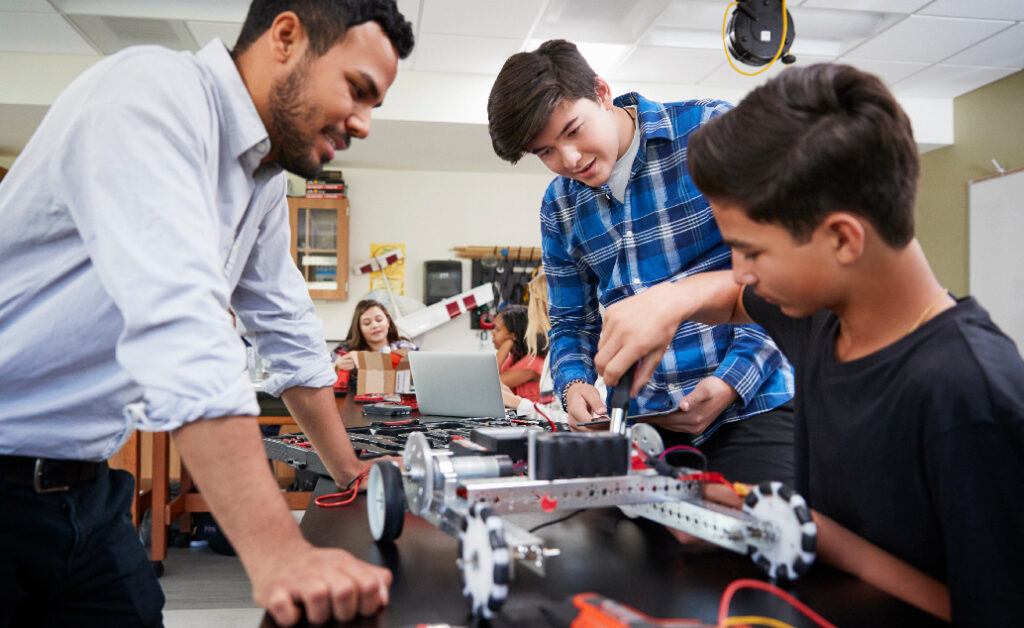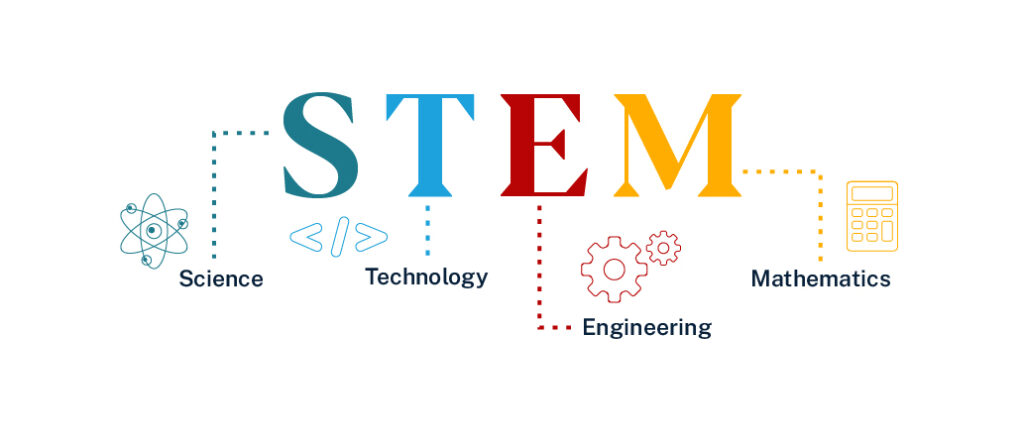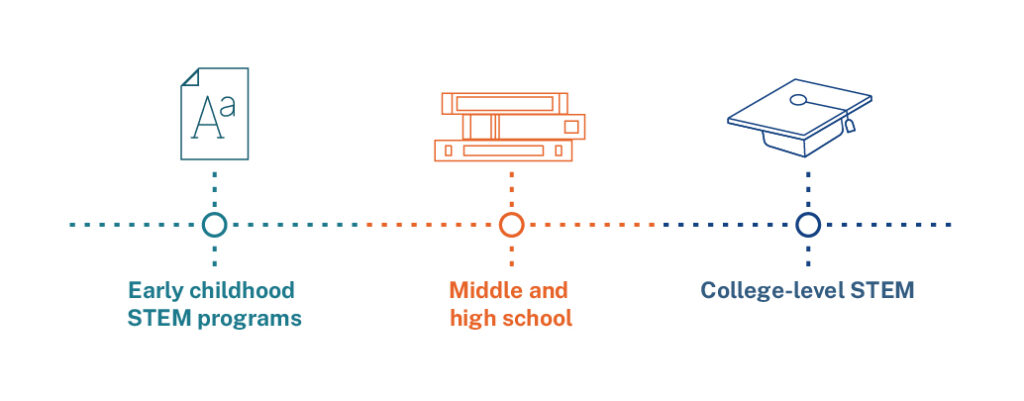
Science, technology, engineering and mathematics (STEM) education emphasizes critical thinking, problem-solving and collaboration to prepare students for the complexities of the modern world. STEM education equips learners with essential skills for an increasingly technology-driven economy.
By nurturing students’ analytical abilities and creative thinking, STEM education prepares bright young minds for a wide range of careers that address global challenges and drive economic growth.
The History of STEM Education
Aiming to cultivate interdisciplinary approaches to education, initiatives by the National Science Foundation in the late 1990s led to the first dedicated STEM programs in the United States. Since then, STEM education has evolved.
The 2007 launch of the STEM Education Coalition and the implementation of new benchmarks for science education in 2013 raised awareness for its importance in a dynamic and competitive curriculum. Former President Barack Obama’s Educate to Innovate campaign aimed to improve STEM literacy by expanding programs across the country, investing in teacher preparation programs and cultivating public-private partnerships with companies and nonprofits in STEM sectors.
Today, organizations like the National Math and Science Initiative and Code.org have transformed the approach to STEM education. Driven by the increasing demand for skilled workers in technology and innovation, the push for STEM is essential for economic growth and global competitiveness.
Why Is STEM Important?
STEM education drives development and the essential technological advancements for a competitive knowledge economy. Industries that rely on rapidly changing complex technologies like healthcare, manufacturing and information technology often face significant skills gaps and complexity of required expertise. These gaps underscore the need for a well-educated workforce equipped with STEM capabilities to fill critical positions and sustain industry growth.
In order to bridge these gaps, STEM education:
- Promotes critical thinking, analysis and problem-solving skills.
- Develops students’ skills for advanced and specific job roles.
- Enhances students’ abilities to adapt to new challenges.
- Prepares students to develop effective solutions to real world problems.
Comprehensive STEM education equips students to fuel innovation that propels both industry and economic development forward.
STEM Core Components
Each area in STEM contributes unique elements for a holistic teaching and learning approach:
- Science focuses on understanding natural phenomena, fostering curiosity and promoting the scientific method. This includes areas like biology, medicine, botany, chemistry, ecology, zoology and agriculture.
- Technology emphasizes the use and development of tools and systems that enhance efficiency and solve problems. This includes information technology services, computer science, and web and software development.
- Engineering is the practical application of scientific and mathematical principles to design, build and optimize processes, structures or products. This broad discipline includes specialized areas like chemical, biomedical, civil and mechanical engineering.
- Mathematics is the foundational language of STEM that supports precise calculations and logical reasoning across all areas. It includes areas like physics, economics, statistics and financial analysis.
These subjects interconnect in real-world applications: Designing sustainable energy solutions requires scientific research, engineering designs, technological tools and mathematical modeling.

STEM vs. STEAM: What’s the Difference?
STEAM education expands the traditional STEM framework by incorporating the arts. Students can
- Express themselves creatively and master technical concepts.
- Improve their engagement and motivation.
- Enhance their problem-solving abilities by thinking critically and creatively.
This holistic learning experience encourages students to approach challenges from multiple perspectives. STEAM education prepares students for careers in increasingly interdisciplinary fields where creativity and technical skills are essential for innovation.
STEM in Schools
Coordinated and supported district-wide STEM programs have the ability to broaden students’ horizons and enhance their proficiency. Integrating STEM programs in schools can involve several effective strategies:
- Development of project-based learning curricula
- Connecting real-world problems to STEM concepts
- Collaboration with local businesses and universities for mentorship
- Integrating hands-on experiences in the classroom
Online platforms like Khan Academy, Code.org and professional development workshops have free available resources for teachers to enhance their methods. Especially for middle and high schools, robotics clubs, coding camps and science fairs develop STEM enrichment and encourage student engagement through teamwork and creativity. These initiatives help reinforce STEM learning outside the classroom, nurturing a passion for innovation and exploration, and can help inspire students to pursue STEM careers as adults.
Technology in STEM Education
Technology transforms STEM education by creating immersive, interactive and engaging learning experiences:
- Tools like virtual reality (VR) allow students to explore complex concepts and environments. Students can take virtual field trips to distant locations, conduct virtual experiments and visualize science models in 3D, enhancing understanding and retention.
- Artificial intelligence (AI) enriches STEM education by providing personalized learning experiences and creating more inclusive learning environments where all students can thrive. AI-driven platforms can adapt to individual students’ learning paces and styles to address specific challenges and strengths.
- Robotics allows students to engage in hands-on problem-solving and project-based learning. By building and programming robots, students develop critical skills in engineering, coding and teamwork and apply theoretical knowledge in a practical context.
These technologies promote active engagement, which improves motivation and interest in STEM subjects. They encourage collaboration and communication, as students often work in teams to tackle challenges. By integrating technology into STEM education, educators create dynamic learning spaces that develop essential skills and prepare students for future STEM careers in an increasingly technological world.
Lifelong STEM Learning

STEM education is essential at all stages of life and can be tailored to fit the needs and cognitive abilities of different age groups:
- Early childhood STEM programs lay the groundwork for foundational skills by nurturing curiosity and basic understanding through simple experiments. These programs emphasize exploratory learning and help young children develop critical thinking and a love for discovery.
- Middle and high school courses are more structured and specialized, offering in-depth studies in specific areas like physics, computer science or engineering principles. Programs often include lab work where students apply their knowledge practically and explore potential career paths.
- College-level STEM education deepens these skills, preparing students for professional roles through rigorous coursework, research projects and internships that provide real-world experience.
Lifelong learning opportunities in STEM ensure that individuals grow and adapt in an ever-evolving world. Adult learning options include online courses, workshops and certification programs to help professionals upskill or reskill to meet new industry demands. These resources allow professionals to adapt to technological advancements and shifting economic needs.
Challenges in STEM Education
STEM education faces significant challenges that hinder its inclusivity and effectiveness:
- A gender gap persists where women remain underrepresented, particularly in engineering and computer science. Stereotypes, limited role models and biased educational practices can discourage girls from pursuing STEM subjects.
- Accessibility issues pose barriers, especially in low-income communities. Limited funding, inadequate resources and a lack of qualified teachers can influence quality STEM education access. These challenges prevent students in disadvantaged areas from gaining the foundational knowledge and skills needed for higher education or careers in STEM.
Early encouragement, mentorship programs and inclusive curricula that highlight the achievements of women in STEM can combat the ongoing gender gap. Targeted scholarship programs and community partnerships that provide resources, training and expanded after-school STEM programs to underserved schools can bridge these resource gaps.
Departments of education can also tackle challenges by allocating district funding for teacher training and development around STEM education, encouraging their educators to become experts by pursuing master’s degrees in STEM education.
Districts can also invest in infrastructure improvements to ensure that students have access to modern equipment and learning opportunities. Addressing these issues can create a more equitable STEM landscape where talent from all backgrounds can thrive.
STEM Education Around the World
Countries have implemented unique approaches based on their educational philosophies and economic needs:
- In the U.S., STEM education emphasizes inquiry-based learning where students engage in hands-on projects and collaborative problem-solving. The Next Generation Science Standards enhance science education by emphasizing critical thinking and integrating engineering practices.
- China’s more rigorous approach focuses heavily on mathematics and science from an early age. The Chinese education system includes high-stakes testing that drives competition and encourages students to excel in STEM fields. The government has heavily invested in its education system with aims to produce a highly skilled workforce that leads in technology and innovation.
- In Finland, STEM fits into a broader curriculum that emphasizes creativity and critical thinking. Finnish schools prioritize student well-being and a love for learning. This has resulted in high achievement without the pressure of standardized testing. The Finnish government has invested in programs to improve STEM teacher training to bolster educators’ ability to deliver engaging and relevant content.
- Brazil’s Science, Technology, and Innovation in Basic Education program promotes hands-on learning experiences and community engagement, and has successfully increased student interest in STEM subjects.
Initiatives like UNESCO’s STEM for All enhances STEM education globally by providing resources, sharing best practices and encouraging international collaboration. These diverse approaches to STEM illustrate the importance of adapting strategies to local contexts to enhance global educational outcomes.
Preparing Students for the Future
As emerging STEM careers in fields like artificial intelligence, renewable energy, robotics and biotechnology continue to grow, the demand for STEM graduates is skyrocketing. Healthcare, technology, finance and engineering want professionals with strong STEM backgrounds to tackle complex challenges and drive progress forward. STEM education prepares students for specific careers and ensures their competitiveness in a rapidly changing economy.
With advancements in technology and an increasing reliance on data-driven decision-making, job opportunities are expanding rapidly. The Bureau of Labor Statistics projects that STEM jobs will grow by more than 10% by 2033, with many positions requiring advanced technical skills and interdisciplinary knowledge.
As demand for a skilled STEM workforce continues to grow, STEM education will undergo significant transformation. Educators with certificates and degrees specializing in STEM education can have the opportunity to influence and shape STEM instruction and programs. Master’s degrees in STEM education will be especially beneficial, as they give current and aspiring STEM educators the opportunity to learn best practices around tools like AI, VR and other developing educational technology.
FAQs About STEM
STEM education equips learners of all ages with a foundational knowledge of math, science, engineering and technology through hands-on projects and experiential learning.
- Developing critical thinking and problem-solving skills for tackling real-world problems.
- Promoting technological advancements and innovation.
- Contributing to workforce readiness and economic growth.
There is a plethora of STEM-related careers and demand for skilled workers is on the rise. STEM jobs encompass a wide range of positions and industries:
- Education: teachers, lab technicians, research scientists
- Healthcare: pharmacists, genetic counseling, medical imaging specialists
- Science: microbiologists, astronomers, forensic scientists, marine scientists
- Tech: cybersecurity analysts, information technology specialists, software engineers
- Engineering: robotics and aerospace engineers, civil and electrical engineers
- Math: operations analysts, machine learning engineers, statisticians
Parents can support STEM education in many easy and practical ways:
- Encourage exploration and curiosity: Explore nature as a family and encourage children to ask questions about the plants and animals they notice. Support them in researching and finding answers.
- Make playtime STEM time: Toys like LEGOs, at-home science kits and educational board games and puzzles promote STEM skills and enrichment.
- Everyday learning opportunities: Simple kitchen chemistry and math exercises like measuring and counting change all reinforce STEM learning.
STEM encompasses a curriculum with a focus on science, technology, engineering and math, while interdisciplinary STEAM curricula include art in addition to these subjects.
Become a leader in STEM education. Further your career with American College of Education’s fully online M.Ed. in STEM Education degree program.

